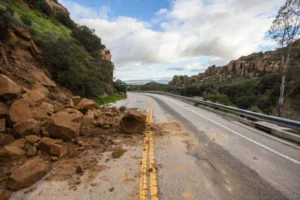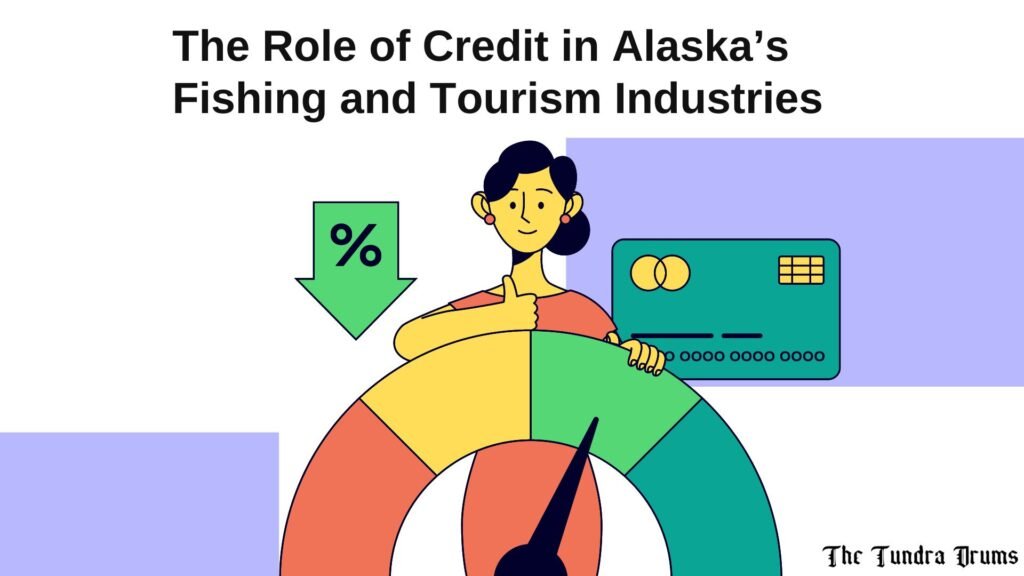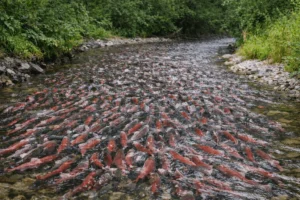Alaska’s economy depends largely on its natural resources, with fishing and tourism as key pillars. As the Last Frontier, Alaska’s clean waters and stunning views shape its culture and bring in a lot of economic activity.
Fishing and tourism together contribute a substantial portion to the state’s Gross Domestic Product (GDP), underscoring their critical roles in sustaining livelihoods and supporting local communities. In recent years, these industries have faced evolving challenges and opportunities, particularly concerning the availability and role of credit, which has become increasingly important in maintaining their resilience and growth.
Understanding the interplay between credit access and the vitality of Alaska’s fishing and tourism sectors is essential for transforming policies that ensure sustainable economic development in the state.
Overview of Alaska’s Fishing Industry and Key Challenges

In 2019, Alaska’s fishing vessels harvested nearly 5.7 billion pounds of seafood, valued at about $2 billion. The processing sector converted this harvest into 2.8 billion pounds of products worth approximately $4.7 billion.
The global credit card market has experienced substantial growth. In the U.S., credit cards currently make up around 40% of in-store purchases and are expected to account for 16% of online shopping transactions by 2026.
When you think about Alaska’s fishing industry, it’s easy to see fleets of boats navigating through icy waters, hauling in the day’s catch. This industry isn’t just a part of Alaska’s heritage; it’s a crucial driver of the state’s economy, supporting thousands of jobs and supplying seafood worldwide. But, like every great story, there are challenges that come with it.
One of the biggest hurdles the industry faces is its seasonal nature. The fishing season is short but intense, which means those involved have to make the most of a few months’ work to sustain them through the year. This seasonal rush can put a lot of pressure on fishermen and related businesses to manage their finances carefully.
1- Seasonal nature of the industry
The fishing season is short but intense, requiring workers to maximize earnings in a few months. The seasonal rush creates financial pressure to sustain income throughout the year.
2- High operational costs
Keeping a fishing vessel operational involves significant expenses, including fuel, maintenance, and crew wages. These costs can be a financial burden, especially with profits tied to the catch’s size and quality.
3- Market volatility and environmental concerns
Fish prices can be unpredictable due to changes in global demand or competition, making income hard to predict. Environmental issues, like climate change and overfishing, threaten fish population sustainability, adding uncertainty to the industry.
Role of Credit in the Fishing Industry
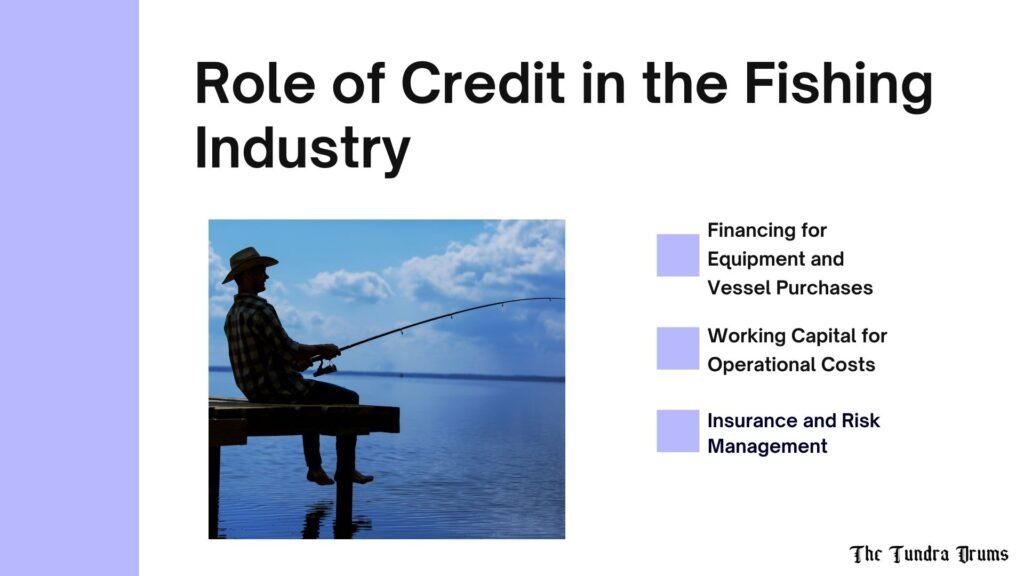
1- Financing for Equipment and Vessel Purchases
The fishing industry relies heavily on up-to-date vessels and equipment to remain competitive and efficient. Credit enables fishermen to invest in the latest technology, such as advanced navigation systems, eco-friendly engines, and efficient processing equipment, which can improve catch rates and reduce operational costs.
Upgrading to newer vessels is often necessary to comply with regulatory standards, enhance safety, and improve fuel efficiency. Credit provides the necessary capital for these significant investments, which can otherwise be out of reach for many operators.
Access to financing allows smaller fishing enterprises to compete with larger entities by enabling them to invest in equipment that can improve their operational capacity and market reach.
2- Working Capital for Operational Costs
The seasonal nature of the fishing industry creates periods where income is low or non-existent, but operational costs remain. Credit provides the working capital needed to cover these expenses, such as fuel, maintenance, and wages, during the off-season.
By ensuring that cash flow is steady, credit helps businesses maintain operations and avoid disruptions that could lead to financial instability or business closure.
Operational costs in the fishing industry are high and can fluctuate based on factors like fuel prices, maintenance needs, and supply costs. Credit allows businesses to manage these day-to-day expenses without depleting their reserves.
3- Insurance and Risk Management
The fishing industry is fraught with risks, from unpredictable weather conditions to accidents at sea. Credit is often necessary to secure comprehensive insurance coverage, protecting businesses against potential losses that could otherwise be devastating.
Insurance premiums can be a significant expense, and credit ensures that businesses can afford the necessary coverage to protect their assets, employees, and operations.
Beyond insurance, credit plays a key role in overall risk management by providing the financial flexibility to respond to market volatility, environmental changes, and other uncertainties. For example, credit can be used to diversify investments or adapt to new market conditions, helping to safeguard against financial losses.
Access to credit allows businesses to plan for the long term, making strategic decisions that balance risk with potential rewards, ensuring sustainability in an industry with inherent uncertainties.
Credit Structures in Alaska’s Fishing Industry
Credit structures in Alaska’s fishing industry provide essential financial support through various options, including short-term loans for operational costs and long-term loans for vessel and equipment investments. These credit options enable fishers to manage seasonal cash flow and invest in sustainable practices for long-term growth.
1- Short-term Loans
Short-term loans are a critical financial tool for fishers in Alaska, especially when dealing with the immediate, high-cost demands of the fishing season. These loans are designed to be repaid within a year, making them ideal for covering operational expenses such as fuel, crew wages, and equipment repairs.
The quick turnaround of these loans aligns with the seasonal nature of the fishing industry, where income is concentrated within a few months. By providing access to necessary funds upfront, short-term loans help fishers maintain smooth operations without depleting their reserves during the off-season.
2- Long-term Loans
Long-term loans are structured to support larger investments that require more time to yield returns. In the context of Alaska’s fishing industry, these loans are often used for purchasing new vessels, upgrading existing equipment, or making substantial improvements to infrastructure.
The extended repayment period, which can span several years, allows fishers to undertake significant projects without placing undue strain on their finances. Long-term loans are essential for those looking to expand their operations or improve efficiency, enabling them to remain competitive in a demanding market.
3- Lines of Credit
Lines of credit offer a flexible financing solution that can be particularly advantageous in the unpredictable environment of Alaska’s fishing industry. Unlike a traditional loan, a line of credit provides fishers with access to funds up to a predetermined limit, which they can draw from as needed.
This structure is especially useful for managing cash flow, allowing fishers to cover expenses during periods of low income and repay the borrowed amount when revenue increases. The ability to borrow and repay on a revolving basis makes lines of credit an invaluable resource for dealing with the cyclical nature of the fishing business, ensuring that fishers can respond swiftly to both opportunities and challenges.
Impact of Credit Access on Small vs. Large-Scale Operations
Access to credit plays a significant role in shaping the operations and growth potential of both small and large-scale fishing enterprises in Alaska, but the impact varies considerably between the two.
For small-scale operations, credit access is often a lifeline that enables them to compete in a challenging industry. Small fishers may rely heavily on short-term loans or lines of credit to manage day-to-day expenses and cover the costs of maintaining their vessels and equipment. Without access to affordable credit, these small operations might struggle to stay afloat, particularly during off-seasons when income is minimal.
Credit also empowers small-scale fishers to make necessary investments in technology or upgrades that can improve their efficiency and profitability, allowing them to better compete with larger players in the market. However, the burden of debt can be heavier for small operations, making it crucial for them to secure favorable terms and manage their credit responsibly.
In contrast, large-scale operations typically have greater access to diverse credit options, including long-term loans for significant investments such as fleet expansion or infrastructure development. These larger businesses often have established relationships with lenders, which can result in more favorable loan terms and larger lines of credit.
This financial flexibility allows them to take advantage of growth opportunities, such as expanding into new markets or adopting advanced technologies, which can further solidify their dominance in the industry. However, even large-scale operations must navigate the risks associated with high levels of debt, particularly in a market as volatile as fishing, where environmental factors and market demand can shift rapidly.
Overview of Alaska’s Tourism Industry
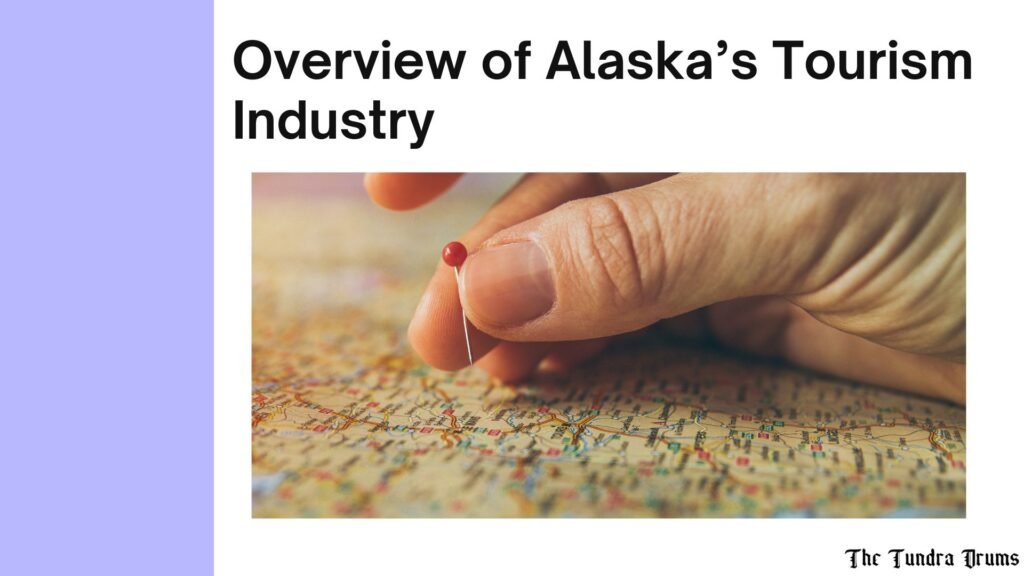
1- Growth and Development of the Tourism Sector
Alaska’s tourism industry has experienced significant growth and development over the past few decades, becoming one of the state’s most vital economic drivers. Known for its breathtaking landscapes, diverse wildlife, and unique cultural experiences, Alaska has successfully attracted millions of visitors annually. The state has invested in expanding infrastructure, such as cruise ports, airports, and lodging facilities, to accommodate the growing number of tourists.
2- Major Tourist Attractions
Alaska is home to some of the world’s most awe-inspiring natural attractions, which are major draws for tourists. The state’s national parks, such as Denali National Park and Glacier Bay National Park, offer stunning views of mountains, glaciers, and diverse wildlife, including grizzly bears, moose, and bald eagles. These parks are complemented by opportunities for outdoor adventures like hiking, kayaking, and fishing.
3- Economic Impact of Tourism on Local Communities
The economic impact of tourism on local communities in Alaska is profound. Tourism generates billions of dollars in revenue each year and supports thousands of jobs across the state, from hospitality and transportation to guided tours and retail. For many remote communities, tourism is a crucial source of income, providing opportunities for local businesses to thrive. Seasonal jobs created by the tourism industry also help sustain the local workforce during the busy summer months.
Key Challenges in the Tourism Industry
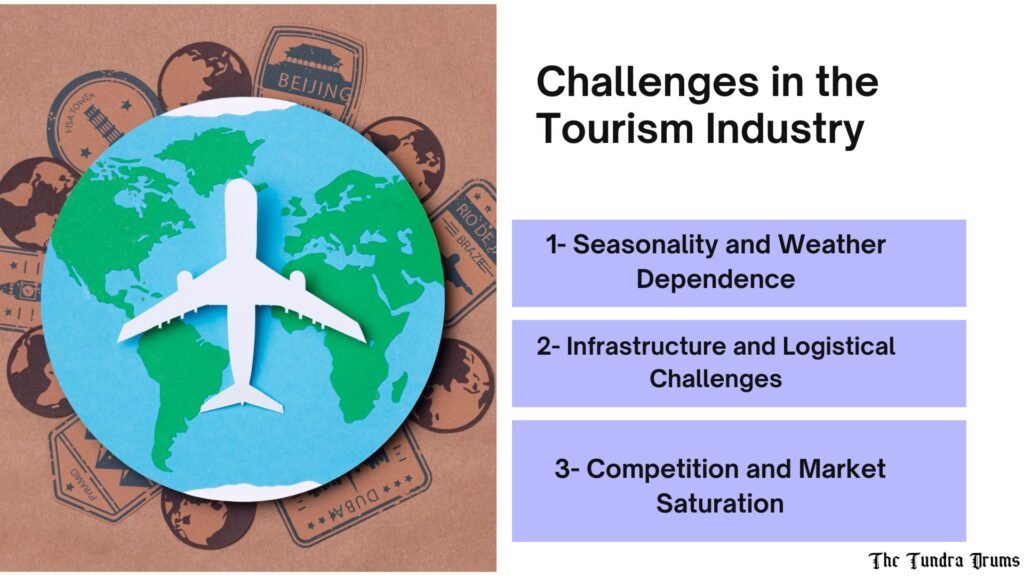
1- Seasonality and Weather Dependence
One of the most significant challenges facing Alaska’s tourism industry is its strong dependence on seasonality and weather conditions. The peak tourist season is relatively short, typically spanning from late spring to early fall when the weather is most favorable for outdoor activities and travel. This seasonality limits the revenue-generating period for businesses, forcing them to maximize earnings in a few months to sustain operations throughout the year.
2- Infrastructure and Logistical Challenges
Alaska’s vast and remote geography presents unique infrastructure and logistical challenges for the tourism industry. Many of the state’s most popular destinations are located in remote areas, accessible only by plane, boat, or long drives, which can complicate travel plans and increase costs for tourists. The limited transportation infrastructure, including roads, airports, and seaports, can become congested during peak season, leading to delays and inefficiencies.
3- Competition and Market Saturation
As the global tourism industry continues to grow, Alaska faces increasing competition from other destinations offering similar natural and cultural experiences. While Alaska’s unique landscapes and wildlife remain strong draws, the state must continually innovate and promote itself to stand out in a crowded market. Additionally, there is the challenge of market saturation within Alaska itself, particularly in popular areas like Denali National Park and the Inside Passage, where the concentration of tourists can lead to overcrowding and strain on natural resources.
Types of Credit Available to Tourism Businesses
Types of credit available to tourism businesses in Alaska include business loans, microloans, and lines of credit, all tailored to support operational needs and growth. These financial tools help businesses manage seasonal fluctuations, invest in infrastructure, and enhance their offerings to stay competitive in a dynamic market.
1- Business Loans (Secured and Unsecured)
In Alaska’s tourism industry, business loans are a primary source of financing for companies looking to expand or improve their operations.
Secured business loans, which are backed by collateral such as property or equipment, often offer lower interest rates and larger loan amounts.
Unsecured business loans provide companies with the flexibility to borrow funds without needing to offer collateral, making them a convenient option for businesses seeking quick access to capital. These loans are ideal for startups or small businesses looking to finance growth, manage cash flow, or cover unexpected expenses.
These loans are typically used for significant investments, such as purchasing new properties, expanding lodging facilities, or upgrading transportation fleets.
2- Microloans for Small Businesses
Microloans are a crucial financial tool for small businesses within Alaska’s tourism sector, especially those just starting or looking to cover short-term expenses.
These loans typically range from a few thousand to tens of thousands of dollars and are designed to provide quick access to capital for small-scale operations.
Microloans are often easier to obtain than traditional business loans, making them accessible to businesses with limited credit history or collateral.
3- Lines of Credit and Credit Cards
Lines of credit and credit cards offer flexible financing options that are particularly useful for managing cash flow fluctuations in Alaska’s tourism industry.
A line of credit allows businesses to borrow up to a certain limit as needed, paying interest only on the amount borrowed. This flexibility is ideal for covering unexpected expenses, such as emergency repairs or seasonal variations in revenue.
Credit cards serve a similar function but are typically used for smaller, more immediate purchases..
Impact of Credit on Small vs. Large Tourism Enterprises
Access to credit significantly influences the operations, growth potential, and sustainability of both small and large tourism enterprises in Alaska, although the effects differ based on the scale of the business.
For small tourism enterprises, such as family-owned lodges, guided tour companies, and local artisans, access to credit is often a vital component of their ability to start and sustain operations. Credit provides these businesses with the necessary capital to manage initial setup costs, cover operational expenses during the off-season, and make small-scale improvements or marketing investments.
Large travel and tourism enterprises, such as hotel chains, cruise operators, and major transportation companies, generally have greater access to a wider range of credit options. These businesses often benefit from established relationships with financial institutions, which can result in more favorable loan terms, larger credit lines, and lower interest rates.
For large enterprises, credit is not just a tool for sustaining operations but also a strategic asset for expansion, innovation, and market dominance. With access to substantial capital, large tourism businesses can invest in significant infrastructure projects, acquire smaller competitors, or develop new attractions and services that enhance their market position. However, even for large enterprises, the responsible management of credit is critical, as over-leverage can lead to financial strain, particularly in a market as unpredictable as tourism.
The Future of Credit in Alaska’s Fishing and Tourism Industries
The future of credit in Alaska’s fishing and tourism industries will be shaped by the need for flexibility, sustainability, and innovation. In the fishing industry, increasing pressure to modernize fleets and adopt sustainable practices will drive demand for specialized loan products, including those that support green technologies and offer flexible repayment terms to manage environmental risks.
In tourism, businesses will likely seek credit to invest in sustainable infrastructure and adapt to changing visitor preferences. Seasonal loan products and lines of credit will remain crucial for managing cash flow during off-peak periods. Additionally, the rise of fintech solutions could provide more accessible and faster credit options, particularly for small and medium-sized enterprises.


